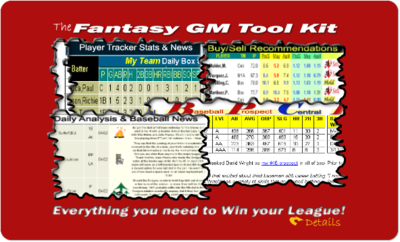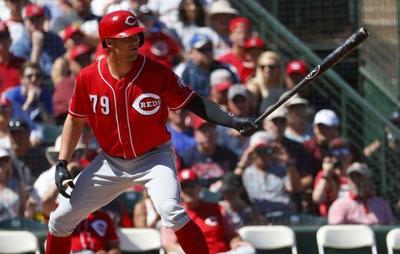In our continuing series on player recommendations, today we
take a look at the pitchers who are deviating from their projected
production.
The past has shown us that pitchers have a more difficult time reverting to their historical mean. Especially top tier pitchers (reason
unknown, apparently if something within a pitcher's makeup is off,
it's much harder to perform at the elite level than at a mediocre level).
While approximately 80% of hitters will revert to the typical production
ranges, only 65% of pitchers will find their normal ranges. Thus trading for
an under-producing pitcher has more risk than trading for an under-producing
hitter. Similarly trading away a over-producing pitcher has a higher
possibility of working out against you (vs trading an over producing
hitter).
The recommendations/rankings are a combination of both Regression
to the Mean and of the underlying SaberMetric fundamentals.
Squarely put, it's a numbers game: 65% of these recommendations will be
spot on, 35% will be awry. I wish the percentages were higher, but it's the
nature of the beast. That said, let's get to it:
Please refer to the
Batters article
for an explanation of the terms used such as
FPI (FPI^
= FPI change over our preseason projection used to access the over or under
production year to date), and the use of the Fantistics
Advanced Stats Database.
OAVG, measures the opposition YTD batting average against each
pitcher. Since we are all familiar with Batting Average, it's easy to see
from this stat who the under and overachieving players are. We are fairly
confident in saying that Jordan Zimmerman is not going to hold the
opposition to a .183 batting average this year. His Balls Hit into play
Success rate of .198, and .79 Strand Rate on .53 K/I ratio, indicates that his recent success is not likely sustainable.
Balls Hit into Play Success % or BHIP% There have been
numerous studies (namely Voros McCracken's article) and rebuttals on the
theory that "all balls put into play stand an equal chance based the law of
percentages"....in other words, all pitchers stand the same chance of
recording an out verses the batter reaching base on balls hit into play
based on the average ratio of hits/outs. Overall,
or internal analysis agrees with this observation however
when you only consider the top echelon of
hurlers, there is a significant correlation which indicates that some
pitchers, particularly successful ones, do have influence over balls hit
into play. The
difference between having a .200 and .300 BHIP% against can mean 3 to 4
extra hits allowed per game. Which could play havoc on the WHIP, ERA, and
Win categories.
The average BHIP% given
up by pitchers is .288 (given up by the top 130 starters). Listed in
the analysis will be each pitchers current BHIP% and their 4 year average
(if available). Using this single indicator we can determine which pitchers
have been "lucky" or "unlucky" to date.
Pitchers who have been extremely fortunate on balls
placed into play (less than a .235 BHIP%) are :
Moore,M. (.149), Harvey,M., Villanueva,C., Iwakuma,H., Rodriguez,W.,
Wood,T., Zimmermann,J., Halladay,R., Weaver,J., Richards,G., Hammel,J.,
Locke,J., Hefner,J., Chacin,J., Marquis,J., Chen,W., Gonzalez,G., Greinke,Z.,
Holland,D., Bumgarner,M., Cueto,J., Hellickson,J.(.235). As mentioned above, a regression to the MLB average
(.288) or their 4 year average could mean a significant rise in all of the
undesirable categories including ERA and WHIP.
On the flip side, Pitchers who have been extremely
unfortunate in balls placed into play (more than a .330 BHIP%) include:
Scherzer,M. (.400), Harrison,M., Sanchez,J.,
Diamond,S., Worley,V., Pelfrey,M., McCarthy,B., Laffey,A., Parker,J.,
Blanton,J., Davis,W., Francis,J., Johnson,J., Haren,D., Hughes,P., LeBlanc,W.,
Anderson,B., Humber,P., Gallardo,Y., Straily,D., Harang,A., Tillman,C.,
Porcello,R., Kazmir,S., Norris,B., Price,D., Volquez,E., Saunders,J.,
Wainwright,A., Vargas,J. (.330).
Not a coincidence is
that many of these pitchers are also pitchers who do not have a high
Strikeout ratio, which has increased their susceptibility to poor luck on
balls hit into play.
Another thing to consider is
the loss of velocity, typically pitchers gain speed with their fastball
as the season progresses. On average most pitchers gain slightly less than 1
MPH from April to the summer months. Courtesy of fangraphs.com, below is a list of pitchers who have a
fastball this early season that is averaging less than 1+ MPH over their
2012 average fastball.

One of the key indicators to pitching success in the majors
is Strikeouts Per Innings Pitched
(K/IP). Very few pitchers are successful with a K/I ratio
below .68. The simple logic behind this ratio threshold is that balls
put into play stand the chance to create runs while strikeouts obviously do
not. High K/I ratios typically indicate that the pitcher has over powering
stuff (usually a very good fastball), or in a few cases has masterful
command of the strike zone with some type of movement (ala vintage Greg
Maddux). You'll see that
some of the under performing pitchers are considerably off in their ratios
this early season...which could be an indication that something is
wrong...it might just be a dead arm period...or a small sample size of only
5 or 6 starts...regardless it is a concern. Here are a few pitchers whose
K/Inning ratio is significantly less than typical so far this year
(greater
than .20 difference): Volquez,E., Gallardo,Y.,
Hanson,T., Blanton,J., Worley,V., de la Rosa,J., Nicasio,J., Hammel,J.,
Strasburg,S., Pelfrey,M., Myers,B., Medlen,K., Chen,W., Niese,J., Porcello,R.,
Sanabia,A., Feldman,S., Norris,B., Saunders,J., Detwiler,R., Weaver,J.,
Maurer,B., Zimmermann,J., Parker,J., Peralta,W., Teheran,J.
Yes seeing undervalued stars who
typically rely on high strikeout rates for their success (Stephen
Strasburg, Kris Medlen, Jon Niese, Jared Weaver) is concerning...
Another indicator included in this year's analysis is Expected ERA (XERA) vs Actual ERA.
As many of you know, ERA can be a category that does translate perfectly to
a pitchers actual production. Those familiar with or
player production charts
already have a handle on the formula created by researchers Gill and
Reeves which approximates the deserved ERA using a series of stats and
ratios. Pitchers who are showing an overly inflated ERA (+1.00) in
relation to their actual production include:
Halladay,R. 3.58, Jackson,E. 3.02, Richards,G. 2.75, Gonzalez,G. 2.61,
McDonald,J. 2.33, Rodriguez,W. 2.27, Peacock,B. 2.24, Darvish,Y. 1.93,
Cain,M. 1.63, Fernandez,J. 1.53, Holland,D. 1.49, Jimenez,U. 1.49,
Quintana,J. 1.28, Worley,V. 1.22, Scherzer,M. 1.17, Harvey,M. 1.16, Maurer,B.
1.14, de la Rosa,J. 1.11, Hellickson,J. 1.04, Kennedy,I. 1.00
Pitchers who are
showing an a better ERA (-1.00) then deserved include:
Santana,E. -1.04, Verlander,J. -1.07, Latos,M.
-1.11, Niese,J. -1.14, Teheran,J. -1.22, Gallardo,Y. -1.25, Slowey,K. -1.27,
Guthrie,J. -1.36, Hughes,P. -1.41, Haren,D. -1.45, Vargas,J. -1.46, Garcia,J.
-1.51, Hanson,T. -1.75, Harrell,L. -1.78, Detwiler,R. -1.92, Westbrook,J.
-1.97, Hefner,J. -2.22, Blanton,J. -2.29
By looking at our key indicators (which can be found in our
Advanced Stats Database
you can tell who has reached a peak and who has bottomed out....it's your
advantage to know where the players are projected to produce and were they
are today. It's difficult to get top dollar on relatively unknown
players who are over producing, like Jeremy Guthrie ...and if you can
not, then it makes more sense to keep them than trade them cheaply. However
for the over producers who are seasoned, you should be able to get
considerable compensation in return. Good pitching is difficult to find,
and it's also very volatile. You'll see a sell recommendations on
pitchers such as Anibel Sanchez and Clay Buchhilz. Both are pitching
well above their mean and front runners in the Cy Young race, however
neither will likely sustain their current pace.
Sure some players will continue on their downward slope and
others will continue to rise, but in the end...."regression to the mean"
rewards those with patience. With 5 weeks in the books, there are still
21 to go...
Click here for the Pitcher's report:
http://www.fantistics.com/baseball00/StrategyPlus-Pitchers-May2013.pdf
Click here for the Hitter's report:
http://www.fantistics.com/baseball00/StrategyPlus-Hitters-May2013.pdf




















